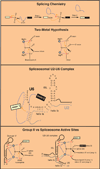snRNA catalysts in the spliceosome's ancient core
- PMID: 24315092
- PMCID: PMC4162089
- DOI: 10.1016/j.cell.2013.11.022
snRNA catalysts in the spliceosome's ancient core
Abstract
The spliceosome, an assembly of snRNAs and proteins, catalyzes the removal of introns from premessenger RNAs. A new study identifies specific phosphates in the U2-U6 snRNA complex that position two catalytic metals. Remarkably, these correspond precisely to metal-binding phosphates in a homologous structure of Group II self-splicing introns, long proposed to be the ribozyme progenitor of spliceosome.
Copyright © 2013 Elsevier Inc. All rights reserved.
Figures

Comment on
-
RNA catalyses nuclear pre-mRNA splicing.Nature. 2013 Nov 14;503(7475):229-34. doi: 10.1038/nature12734. Epub 2013 Nov 6. Nature. 2013. PMID: 24196718 Free PMC article.
Similar articles
-
RNA catalyses nuclear pre-mRNA splicing.Nature. 2013 Nov 14;503(7475):229-34. doi: 10.1038/nature12734. Epub 2013 Nov 6. Nature. 2013. PMID: 24196718 Free PMC article.
-
The RNA binding protein Cwc2 interacts directly with the U6 snRNA to link the nineteen complex to the spliceosome during pre-mRNA splicing.Nucleic Acids Res. 2009 Jul;37(13):4205-17. doi: 10.1093/nar/gkp341. Epub 2009 May 12. Nucleic Acids Res. 2009. PMID: 19435883 Free PMC article.
-
An RNA-dependent ATPase associated with U2/U6 snRNAs in pre-mRNA splicing.Nature. 1996 Jun 20;381(6584):709-13. doi: 10.1038/381709a0. Nature. 1996. PMID: 8649518
-
RNA splicing. Activity in the spliceosome.Curr Biol. 1994 May 1;4(5):462-4. doi: 10.1016/s0960-9822(00)00104-4. Curr Biol. 1994. PMID: 7922366 Review.
-
The role of PRP8 protein in nuclear pre-mRNA splicing in yeast.J Cell Sci Suppl. 1995;19:101-5. doi: 10.1242/jcs.1995.supplement_19.15. J Cell Sci Suppl. 1995. PMID: 8655640 Review.
Cited by
-
The Conservation and Function of RNA Secondary Structure in Plants.Annu Rev Plant Biol. 2016 Apr 29;67:463-88. doi: 10.1146/annurev-arplant-043015-111754. Epub 2016 Feb 8. Annu Rev Plant Biol. 2016. PMID: 26865341 Free PMC article. Review.
-
THUMPD2 catalyzes the N2-methylation of U6 snRNA of the spliceosome catalytic center and regulates pre-mRNA splicing and retinal degeneration.Nucleic Acids Res. 2024 Apr 12;52(6):3291-3309. doi: 10.1093/nar/gkad1243. Nucleic Acids Res. 2024. PMID: 38165050 Free PMC article.
-
Structure, Regulation, and Function of Linear and Circular Long Non-Coding RNAs.Front Genet. 2020 Mar 3;11:150. doi: 10.3389/fgene.2020.00150. eCollection 2020. Front Genet. 2020. PMID: 32194627 Free PMC article. Review.
-
GL4SDA: Predicting snoRNA-disease associations using GNNs and LLM embeddings.Comput Struct Biotechnol J. 2025 Mar 12;27:1023-1033. doi: 10.1016/j.csbj.2025.03.014. eCollection 2025. Comput Struct Biotechnol J. 2025. PMID: 40160859 Free PMC article.
-
RNA structure drives interaction with proteins.Nat Commun. 2019 Jul 19;10(1):3246. doi: 10.1038/s41467-019-10923-5. Nat Commun. 2019. PMID: 31324771 Free PMC article.
References
-
- Butcher SE. The spliceosome and its metal ions. Metal ions in life sciences. 2011;9:235–251. - PubMed
Publication types
MeSH terms
Substances
Grants and funding
LinkOut - more resources
Full Text Sources
Other Literature Sources
Molecular Biology Databases

